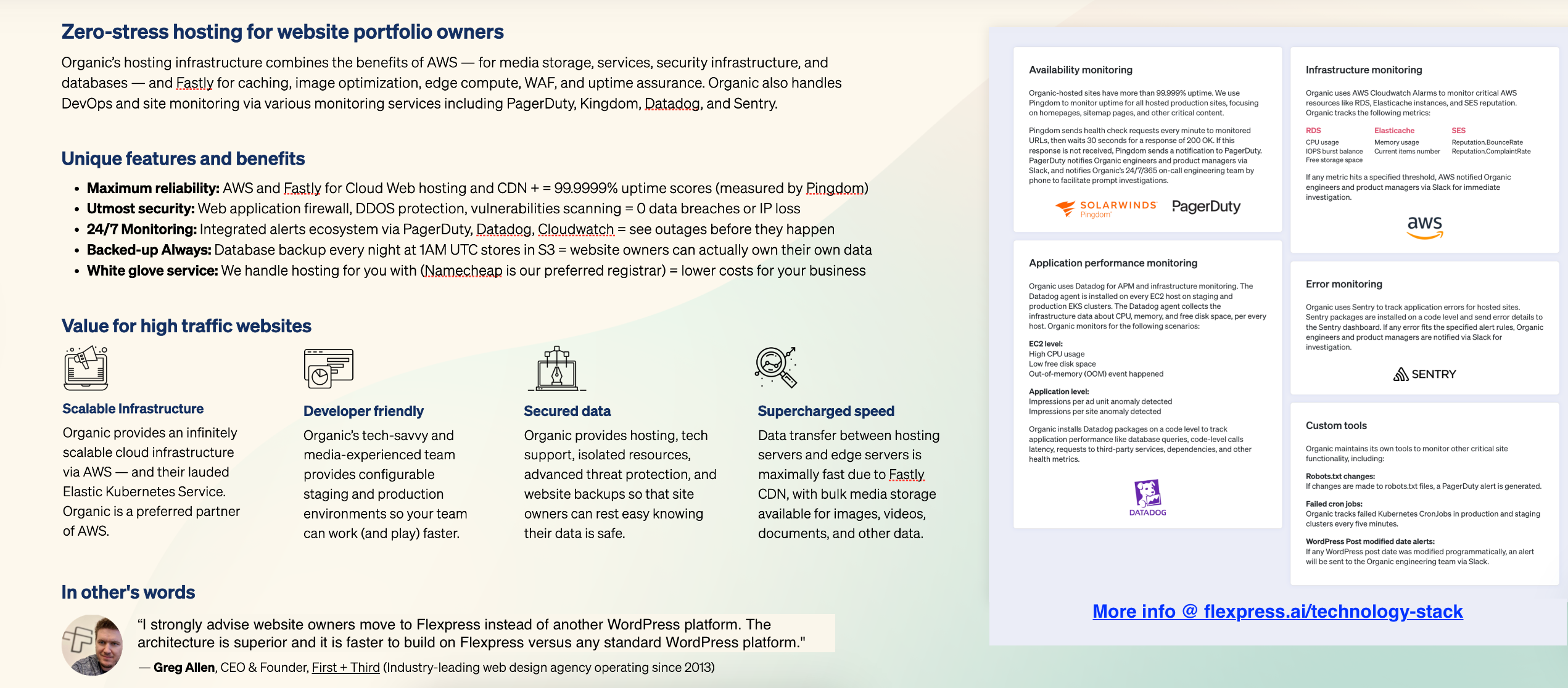There are two ways to newly launch an open source, high-traffic website:
- Move an existing high-traffic website (or portfolio of websites) to a new and better-performing platform
- Create a new website intended for a specific large audience, around events for example
Let’s take a look at how to make the best decision for the business keeping in mind a preference for open source software solutions, encouraged by the dialogue from this Reddit thread: “I’m looking to create a new website, what are the best open source content management systems available currently?”

Open Source, High-Traffic Website: Specific Needs
Launching a website that garners high traffic in today’s digital era represents a significant achievement and a substantial challenge. High-traffic websites are not just about engaging content; they deliver an exceptional user experience under any load. High traffic websites need to withstand the demands of a large audience, from scalability and performance optimization to security and content delivery.
1. Scalability and Infrastructure: one of the foremost considerations is ensuring your website’s infrastructure is built to scale. Scalability involves having a flexible system that can expand to accommodate growing numbers of users and data without compromising on performance. Websites need technical elasticity, allowing them to adjust resources dynamically based on traffic.
2. Performance Optimization: a fast-loading website is non-negotiable for high-traffic scenarios. Performance optimization techniques like image compression, minifying CSS/JS files, and leveraging browser caching can significantly reduce load times. Additionally, implementing lazy loading ensures that content is loaded only when needed, enhancing site speed.
3. Caching Mechanisms: caching is crucial for offloading the server and improving the response time for your users. Effective use of caching mechanisms, such as browser and server-side caching, can dramatically reduce the load on your infrastructure, ensuring that your website remains responsive even during traffic spikes.
4. Security Measures: with high traffic comes greater security responsibility. Implementing SSL/TLS encryption, securing databases, and regular security audits can protect your site from common vulnerabilities. Employing a web application firewall (WAF) can help safeguard your website from attacks and unauthorized access.
5. Content Delivery Network (CDN): a robust CDN is essential for high-traffic websites with a global audience. CDNs store copies of your site’s content on servers worldwide, reducing latency by serving content from a location nearest to the user. This speeds up content delivery and reduces the load on your primary server.
6. Monitoring: continuous monitoring of your website’s performance and user behavior analytics can provide insights into potential bottlenecks and areas for improvement. Tools like Google Big Query and web performance monitoring services can help you track user engagement and site speed, allowing data-driven decisions to enhance user experience.
7. Monetization: Monetization allows high-traffic websites to not only survive but also thrive. It fuels content creation, innovation, and the overall growth of the website as a business entity.
8. Content <> Revenue Analytics: cross-channel analytics provide a comprehensive understanding of how content and various channels work together to generate revenue. This empowers data-driven decision-making that truly drives conversions and, ultimately, profits from content strategy, resource allocation, and revenue streams.
Launching a high-traffic website requires meticulous planning and execution across various aspects, from infrastructure to user experience. You can create a resilient website that serves a large and diverse audience by prioritizing scalability, performance, security, and efficient content delivery. Remember, the goal is not just to attract high traffic but to provide a seamless and secure experience that keeps users coming back.
.jpeg)
Select the Right Web Hosting Partner: Open Source, High-Traffic Website
Choosing the right web hosting provider is a critical decision when launching a new website. Several factors to consider include reliability, performance, scalability, and customer support. Look for a hosting provider with high uptime guarantees and a proven track record of delivering reliable services. It’s also important to consider the type of hosting that best suits your needs, such as shared hosting, virtual private servers (VPS), or dedicated servers.
Additionally, consider the scalability options offered by the hosting provider. As your website grows and attracts more traffic, you may need to upgrade your hosting plan or infrastructure. Ensure that the provider offers seamless migration options and can handle the increased demands of a high-traffic website. Lastly, don’t forget to evaluate the level of customer support provided by the hosting company. In case of any issues or technical difficulties, it’s crucial to have responsive and knowledgeable support to assist you.
Our advice: hire someone to do the hosting for you. With an intent of delivering high traffic, there are better places to focus.
Data Security, Uptime, and Compliance
Data security is of utmost importance when launching a new website. Implement robust security measures to protect user data and prevent unauthorized access. This includes using SSL certificates to encrypt data transmission, regularly updating software and plugins to patch vulnerabilities, and implementing strong user authentication mechanisms.
In addition to data security, uptime is another crucial factor to consider. Choose a reliable hosting provider that guarantees high uptime percentages. This ensures that your website is accessible to users at all times and minimizes any potential downtime. It’s also important to ensure compliance with relevant regulations and standards, such as GDPR or PCI-DSS, depending on the nature of your website and the data you handle. By prioritizing data security, uptime, and compliance, you can build trust with your audience and protect your website from potential threats.
Above all, again, let someone technical take this off your plate. Creatives having to worry about these technical, in-the-weeds processes means the business is spending less time generating high E-E-A-T content.
-1.jpeg)
Designing Modern Visual Experiences: Open Source, High-Traffic Website
In today’s digital landscape, having a visually appealing and user-friendly website is crucial for attracting and retaining visitors. When designing your website, consider modern visual trends and best practices. If you’re worried about using responsive design that adapts to different screen sizes and devices, you’re working with the wrong team. Every digital experience should be seamless for mobile and web users alike. Pay attention to typography, color schemes, and overall aesthetics to create a visually appealing website, which results in longer session times and more revenue.
Furthermore, optimize the website’s layout and navigation to enhance user experience and make it easy for visitors to find what they want. Incorporate interactive elements like videos, animations, or sliders to engage users and make the website more dynamic. By designing modern visual experiences, you can leave a lasting impression on your audience and encourage them to explore your website further.
All of these are essentially the arguments for doing open source, headless CMS.
.jpeg)
While WordPress and Drupal reign supreme, a plethora of lesser-known open-source options are out there, including:
- October CMS: Built on the Laravel framework; utilizes Twig for templating, user-friendly experience
- PyroCMS: Built on a Laravel-based option, PyroCMS boasts a steeper learning curve but caters to complexity
- Strapi: headless CMS, built with Node.js and MongoDB, provides an API-driven approach to content management
- Django CMS: utilizes Python and Django frameworks and presents a well-established option for developers familiar with these technologies.
- Craft CMS: Built on the Yii framework, Craft CMS offers intriguing features that are waiting to be explored.
Keep in mind that there is a wide array of CMS choices available. With options catering to diverse needs and technical preferences, developers are not limited. You’ll also hear about XAMPP (a development server that streamlines the process of experimenting with various CMS options, allowing developers to test-drive features and functionalities before committing to a specific platform).
Regardless, WordPress and Drupal are the choice for high-traffic websites, given the inherent risks associated with using lesser-known open-source CMS options. These risks include:
-
Security Concerns:
-
Limited Community & Resources: Compared to the vast communities surrounding WordPress and Drupal, less popular CMS platforms might have fewer developers actively contributing to security patches and vulnerability fixes. This can leave your website exposed to potential exploits for longer durations.
- Scrutiny risk: With a smaller user base, these platforms might not receive the same level of scrutiny from security researchers. Undiscovered vulnerabilities could pose a greater risk.
-
-
Scalability Challenges:
- Limited Development Resources: Popular platforms like WordPress have a vast ecosystem of plugins and themes designed explicitly for handling high-traffic demands. Finding such optimized solutions might be scarce for lesser-known CMS options.
- Performance Optimization: Extensive customization might be required to optimize the core CMS code to handle the strain of high traffic volumes. This can be a complex and resource-intensive task.
-
Limited Support:
- Smaller Community: A smaller community translates to fewer readily available resources like tutorials, troubleshooting guides, and forums compared to the extensive support networks offered for WordPress and Drupal.
- Finding Developers: The pool of developers familiar with these platforms might be limited, making it challenging to find qualified individuals for maintenance, customization, or troubleshooting.
Additional Considerations:
- Learning Curve: Adapting to a new, less popular CMS might require additional learning and investment in acquiring the necessary expertise for your team.
- Lack of Advertising Partners: most ad and other revenue-generating partners will not be able to integrate off the bat with less widely-used CMS platforms
- Future-proofing: The long-term viability of the platform becomes a concern. Less popular options might risk being abandoned or not receiving active development in the future.
.jpeg)
Therefore, while open-source alternatives offer exciting features and customization possibilities, the trade-off in terms of potential security vulnerabilities, scalability limitations, and reduced support resources can be significant for high-traffic websites. It’s crucial to carefully weigh the benefits against the risks before choosing a less popular CMS for a high-traffic website. Consulting with experienced developers and conducting thorough research is essential to ensure your website’s security, performance, and long-term maintainability.
Support for Multiple Websites: Open Source, High-Traffic
Given that you’re more than likely to launch multiple websites or manage multiple domains with high traffic, choosing a content management system (CMS) that supports this functionality is important. Look for a CMS that allows you to easily create and manage multiple websites from within a single platform. This can save you time and effort by streamlining the management process.
Additionally, consider the scalability options provided by the CMS. As your website portfolio grows, you’ll need a CMS that can handle the increased demands and accommodate future expansion. Look for features such as multisite management, customizable templates, and flexible content organization. By selecting a CMS with robust support for multiple websites, you can efficiently manage your online presence and ensure a consistent user experience across all your sites, which is especially important for strategies such as affiliate content and earnings growth.
.jpeg)
Growing via Search, Syndication, Recirculation: Open Source, High-Traffic Website
To grow your website audience, it’s important to employ effective search engine optimization (SEO), content syndication, and recirculation strategies. By optimizing your website for search engines, you can improve its visibility in search results and attract organic traffic. This involves researching keywords, optimizing on-page elements such as meta tags and headings, and building high-quality backlinks.
Content syndication refers to distributing your content on external platforms to reach a wider audience. This can include guest blogging, submitting articles to industry publications, or partnering with influencers to promote your content. By leveraging the reach of established platforms, you can increase your website’s exposure and attract new visitors.
Recirculation keeps visitors engaged and encourages them to explore your website’s content more. Implement related post recommendations, internal linking, and personalized recommendations based on user behavior to increase the chances of visitors staying longer on your site and discovering additional content. By employing these strategies, you can attract a larger audience and increase engagement on your website.
Earning and Diversifying Revenue, While Scaling Up: Open Source, High-Traffic Website
When launching a high-traffic website, it’s important to consider revenue generation and diversification. You can explore various monetization methods, such as advertising, affiliate marketing, sponsored content, or selling digital subscriptions. Evaluate the options that align with your website’s niche and target audience.
.jpeg)
As your website scales up and attracts more traffic, optimizing for further revenue generation is crucial. This can involve conducting A/B testing, analyzing user behavior and preferences, and refining your monetization strategies accordingly. Additionally, consider diversifying your revenue streams to reduce reliance on a single source. This can involve exploring new advertising networks, partnering with different brands, or launching premium services or subscriptions.
By focusing on earning and diversifying revenue while scaling up, you can build a sustainable business model and generate income from your high-traffic websites. Simply put, some CMS platforms lack the features needed for monetization; avoid them at all costs.
Maximizing Engagement and Loyalty: Open Source, High-Traffic Website
Engaging your audience and fostering brand loyalty are key factors in the success of a high-traffic website. Implement strategies to encourage user interaction and feedback, such as comment sections, social media integration, or online forums. This allows users to connect with your brand and feel a sense of community.
Additionally, create valuable and relevant content that resonates with your target audience. Conduct market research, analyze user demographics and preferences, and tailor your content accordingly. Regularly update your website with fresh and engaging content to keep visitors coming back for more.
Furthermore, leverage social media platforms to amplify your reach and engage your audience. Share your content, interact with followers, and encourage user-generated content. By building a strong online presence and fostering brand loyalty, you can create a loyal community of visitors who actively engage with your website and advocate for your brand.
.jpeg)
That’s how to create organic growth.





